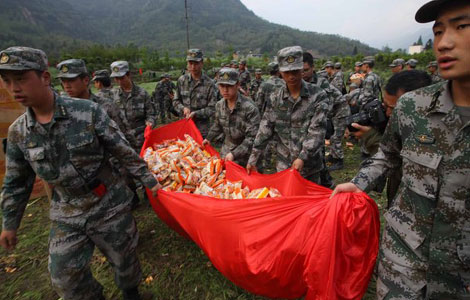Ex-diplomat Holliday busy as cultural envoy
Updated: 2012-06-15 11:22
By Tan Yingzi in Washington (China Daily)
|
||||||||
|
Stuart Holliday, president of Meridian International Center in Washington and a former US diplomat at the United Nations, talks about Metropolis Now, an exhibit of modern Chinese art that his organization helped organize. Sun Chenbei / China Daily |
From serving as US representative on the United Nations Security Council and leading a prestigious cultural institution in Washington, Stuart Holliday is well practiced in diplomacy.
"The old public diplomacy was, 'You tell me what you think and I tell you what I think, and that's the end,'" the former ambassador told China Daily at the Meridian International Center, which is situated in a historic mansion in the US capital.
"The new public diplomacy is, 'We get to know each other better by working on that common issue or challenge than by spending time trying to convince each other on a point of argument,'" he said.
Holliday became president of Meridian, which promotes exchanges of US and foreign business, government and civilsociety leaders, after serving as US ambassador for special political aff airs to the UN from 2003 to 2005.
His career in public service included experience working with Chinese diplomats to address global challenges, but today he believes the two major world powers should fortify their long-term relationship through people-to-people exchanges.
Under Holliday, the organization- founded in 1960 as Meridian House - has been working closely with Chinese counterparts in its mission to advance US efforts at public and cultural diplomacy. Last year, Meridian and the China International Culture Association agreed to promote exchanges between the two countries, including the launch of the American-Chinese Cultural Initiative, or ACCI.
ACCI is a public-private partnership of US and Chinese businesses, nonprofit organizations and government entities. It seeks to deepen cross-cultural understanding through exchange programs in art, music, dance, film and other cultural forms.
Meridian hopes to be the "glue" that holds together the private sector, government and cultural institutions, so as to maximize communication between the US and China, Holliday said.
He recently returned from Beijing where he accompanied US Secretary of State Hillary Clinton at the bilateral Strategic and Economic Dialogue and the 2012 Consultations on Peopleto-People-Exchanges.
Th e State Department selected private-sector partners and organizations including Meridian, the Thomas Jeff erson Foundation, the Philadelphia Orchestra and the Asia Society to stimulate exchanges with their counterparts in China under the CPE, Holliday said.

In Beijing, the US Embassy and Meridian opened an exhibit of photos depicting jazz, that quintessentially American music, at China's National Center for Performing Arts on May 7. The exhibit, Jam Session, traveled throughout China for three weeks.
Meridian previously staged a series of Chinese and American art exhibits in both countries, such as Metropolis Now, a collection of Chinese modern art, and Out West: the Great American Landscape.
"The idea of those exhibitions is that we do something to tell a story,"Holliday said. "We want to find a topic that we share common challenge, such as urbanization and conservation of local culture."
He praised Meridian's Chinese partner for cooperation and support in making a rich variety of art available to the US institution."They give us recommendations and we can pick what we think Americans will like," the diplomat explained.
In addition to exhibitions, Meridian through the ACCI hosts exchanges and training programs for Chinese arts management professionals.
"Our challenge is to go from occasional to consistent and ongoing," Holliday said.
He has been particularly impressed by the creativity of Chinese people, recalling that when he wandered around Art District 798 in suburban Beijing, he felt like he was in Southern California.
"The idea of creativity from China is most fascinating - the idea that Chinese art is not just Chinese art but it is world art. It's art competing for the eyes of people all over the world.
"It's because people are allowed to express themselves and they like to create. That's a very important point that should be encouraged."
tanyingzi@chinadailyusa.com

 Relief reaches isolated village
Relief reaches isolated village
 Rainfall poses new threats to quake-hit region
Rainfall poses new threats to quake-hit region
 Funerals begin for Boston bombing victims
Funerals begin for Boston bombing victims
 Quake takeaway from China's Air Force
Quake takeaway from China's Air Force
 Obama celebrates young inventors at science fair
Obama celebrates young inventors at science fair
 Earth Day marked around the world
Earth Day marked around the world
 Volunteer team helping students find sense of normalcy
Volunteer team helping students find sense of normalcy
 Ethnic groups quick to join rescue efforts
Ethnic groups quick to join rescue efforts
Most Viewed
Editor's Picks

|

|

|

|

|

|
Today's Top News
Health new priority for quake zone
Xi meets US top military officer
Japan's boats driven out of Diaoyu
China mulls online shopping legislation
Bird flu death toll rises to 22
Putin appoints new ambassador to China
Japanese ships blocked from Diaoyu Islands
Inspired by Guan, more Chinese pick up golf
US Weekly

|

|








